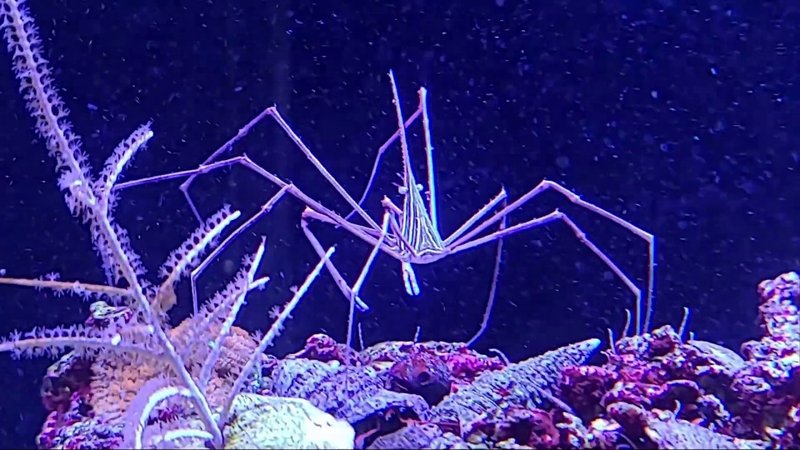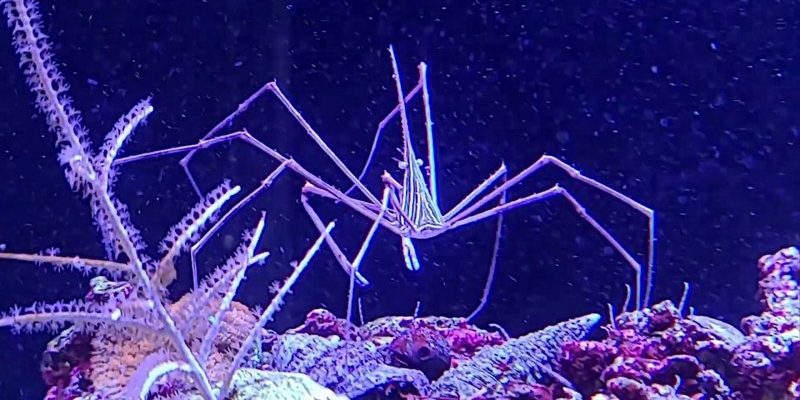
Adding arrow crabs to your tank can sound like a great plan on paper. They’re known for snacking on bristle worms, which could be a win for your tank’s health. But here’s the catch—while arrow crabs can help with bristle worm control, they come with their own set of challenges. Just like choosing the right remote for your TV, you have to think carefully about whether these crabs are the best fit for your unique situation.
What Are Arrow Crabs?
Arrow crabs are fascinating creatures that belong to the family Majidae. They have long legs, a unique body shape, and are often seen picking at the substrate or rocks in a tank. You might think of them as the “cleaners” of your aquarium, searching for scraps of food and tiny pests. But more importantly, they are known for their appetite for bristle worms.
Like nature’s custodians, arrow crabs can help maintain the balance of your tank’s ecosystem. They can grow to about 4-6 inches in size and have a mix of colors, typically brown or green with noticeable spiny features. Their long legs allow them to scuttle around the rocks and coral, making them effective scavengers. Just imagine them as tiny custodial workers, busily cleaning up while you enjoy the view.
Understanding Bristle Worms
Before you decide to add arrow crabs for bristle worm control, it’s essential to understand what bristle worms are. These creatures are often viewed as pests in aquariums, but they actually play a role in the ecosystem as decomposers. Bristle worms can grow quite long—some species reaching up to a foot! They have bristly segments that can cause irritation if you touch them, which is why they’ve earned their bad reputation.
While bristle worms do help break down organic matter, they can reproduce quickly and become a nuisance. A small population is usually harmless, but when they start multiplying, it can disrupt the delicate balance of your tank. Picture this: your once-beautiful aquarium is now overrun with these pesky worms. That’s where arrow crabs come in, potentially offering a solution.
The Pros of Adding Arrow Crabs
So, what are the upsides of adding arrow crabs to your tank? Let’s break it down.
- Natural Predators: Arrow crabs are known for their affinity for bristle worms. They actively hunt and eat them, which can help keep the population in check.
- Algae-Control: Besides bristle worms, arrow crabs also help clean up excess algae, making your tank look better.
- Engaging Behavior: These crabs can be fun to watch. Their foraging habits add life and movement to your aquarium.
Arrow crabs can make the environment healthier, giving you peace of mind. If you’re overwhelmed by bristle worms, arrow crabs might be a natural solution that works well in your aquarium setup.
The Cons of Adding Arrow Crabs
Now, it’s not all sunshine and rainbows when it comes to arrow crabs. Before you rush to make a purchase, let’s look at some of the potential downsides.
- Compatibility Issues: Arrow crabs can be territorial. They might not get along with everyone in your tank and could stress out other fish or invertebrates.
- Overpopulation Risk: If you don’t have enough bristle worms for them to eat, arrow crabs may start snacking on your coral or smaller fish. This could lead to more problems than you started with!
- Care Requirements: Like all aquarium inhabitants, arrow crabs need proper care. If conditions aren’t right (like water temperature or salinity), they may not thrive.
Balancing the benefits and drawbacks is crucial. After all, it’s essential to create a harmonious living environment for all your aquatic friends.
How to Introduce Arrow Crabs to Your Tank
If you’ve weighed the pros and cons and are ready to add arrow crabs, here’s how to make that happen smoothly.
1. **Choose a Healthy Specimen:** Look for active and healthy crabs at your local aquarium store or online. Make sure to ask about their diet and care needs.
2. **Acclimate Slowly:** Before you introduce them, it’s crucial to acclimate arrow crabs to your tank’s environment gradually. Floating the sealed bag in your aquarium for about 15-20 minutes before releasing them can help.
3. **Provide Hiding Spaces:** Ensure there are places in your tank where the crabs can hide. This reduces stress and gives them a sense of security.
4. **Monitor Behavior:** After adding arrow crabs, keep a close eye on them. Watch how they interact with existing tank members to ensure everything runs smoothly.
Like a new friendship, giving your arrow crabs time to adjust can lead to a more harmonious tank.
Alternatives for Bristle Worm Control
If you’re still on the fence about adding arrow crabs, consider other options for bristle worm control.
- Manual Removal: If you spot a few bristle worms, you can carefully remove them with tweezers. Just make sure to wear gloves!
- Other Predators: Certain fish, like wrasses, and some invertebrates, like certain types of shrimp, will munch on bristle worms. Research which ones would work best in your tank.
- Reducing Overfeeding: One of the simplest ways to manage bristle worms is by ensuring that you’re not overfeeding your fish. Less food means fewer worms can thrive!
Each option has its pros and cons, so weigh your choices carefully before deciding.
Final Thoughts
So, should you add arrow crabs for bristle worm control? It really comes down to your specific situation. If you have a manageable number of bristle worms and a diverse tank, arrow crabs could be a valuable addition. But if your tank is small or delicate, or if you’re worried about compatibility, it might be worth exploring other methods.
Remember, every aquarium and its inhabitants have unique needs. Whether you go with arrow crabs or another solution, the goal is to keep your underwater world healthy and happy. Whatever you choose, remember that the most crucial part of this hobby is enjoying the process of creating a vibrant ecosystem right in your own home.

